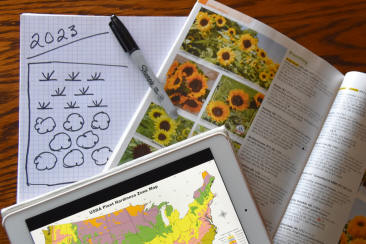 As the year ends, many gardeners find their mailboxes bursting with seed catalogs full of pictures of colorful flowers and plump vegetables. Anticipation of warmer temperatures and getting outside again can tempt even the most stoic gardener to place an immediate order! But before you do that, letís take some time to reflect on the past year and plan for the next year.
As the year ends, many gardeners find their mailboxes bursting with seed catalogs full of pictures of colorful flowers and plump vegetables. Anticipation of warmer temperatures and getting outside again can tempt even the most stoic gardener to place an immediate order! But before you do that, letís take some time to reflect on the past year and plan for the next year.
Think about last yearís garden. What did you like? What didnít you like? Which plants grew well? Which struggled to survive? Did you attempt too much? Did you wish you had planted more of one type of plant or something altogether different?
What are your goals for the upcoming year? Perhaps you want to branch out from flowers to include a vegetable patch or an herb garden. Maybe you want to encourage more pollinators or wildlife to visit your garden. Is it time to replace those invasive bushes with native species?
Consider the space in which you garden. Do you have areas that are especially sunny? Are there sections with lots of shade? Do you have places that never seem to dry out or other spots that are always thirsty? Did pests or weeds take over some of your garden space?
Once you have evaluated last yearís garden, you can begin to plan for next year with specific changes in mind. As we dreamily look through our seed catalogs or stroll through the local nurseries, understanding what will work best in our own piece of the world is an important part of success.
Were last yearís plants the right plant for the place in which they grew? If you try growing plants not meant for this area, you can quickly become frustrated at the lack of success. Adams County is in the USDAís Planting Zone 6b, which means not everything will not grow well here. Tropical plants wonít last year-round outside. In fact, the season to grow them might be too short to even try. Youíll be disappointed trying to grow sunflowers in a shady yard and plants that thrive in wet areas will not be happy in dry soil. Knowing what you can and cannot grow will save you frustration later.
If you see something in your catalogs that you like, do some research on the plant before you place an order for it. Will it grow in this zone? Does your garden have sufficient sunlight to be successful? You may need to consider a more shade-tolerant variety. If the plant requires a lot of water, do you have the time and resources to keep up with its needs? It may be wiser to select a less thirsty plant. If you have deer or rabbits nearby, check to see if the plant is a yummy snack for them. If so, you will be better off -- and less frustrated Ė looking for deer- or rabbit-resistant plants.
Another consideration is your type of soil. Ensuring your soil has the right nutrients for your plants is important. If you havenít yet, now would be a good time to test your soil so you can have the results before spring planting. Soil test kits are available from your county Penn State Extension office. Results will give you a breakdown of the nutrients in your soil so you can better prepare your soil for success.
After youíve ordered those seeds, take some time to inspect your garden tools. Sharpen, clean, disinfect, and repair as needed. Do you need any new tools, gloves, or accessories so you are ready to begin when the time is right? Do you have the necessary potting mix and containers to start your seeds at the right time?
Grab some paper and chart out your garden. Using grid paper, draw your garden, its features, and its current plants. Understanding plantsí potential height and width can help you choose the best place for each plant. A timeline is another handy chart so you can plot out the right time to begin your seeds and the right time to transplant them. Check your seed packets or catalog for the number of days your seedlings need to maturity. Planning now will save your precious new plants from frost.
Finally, you may want to invest in a journal specific to gardening. Having a way to track what you did this year will give you a jump start to next yearís reflection time since youíll have it all recorded in one place. Record when you started your seeds, temperatures, transplanting dates, and more. I often take photos of my garden throughout the year to supplement my journal. These can be used to assess the stages your garden goes through from early spring to late fall. Photos help jog the memory, especially if taken specifically to remind you of something later. Create a digital file on your computer to store your photos so you can easily refer to them.
Now that youíve reflected on your 2022 garden and planned for the new year, pour yourself a cup of tea, flip through those gorgeous seed catalogs, and start dreaming of warmer days when you can make your 2023 gardening dreams a reality.
Read other articles on garden and landscape design
Read other articles by Brenda Reed